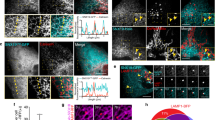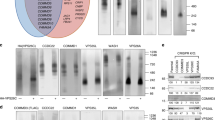Abstract
The sorting nexin (SNX) protein family is implicated in regulating membrane traffic, but the mechanism is still unknown. We show that SNX3 is associated with the early endosome through a novel motif (PX domain) capable of interaction with phosphatidylinositol-3-phosphate (PtdIns(3)P). Overexpression of SNX3 alters endosomal morphology and delays transport to the lysosome. Transport from the early to the recycling endosome is affected upon microinjection of SNX3 antibodies. Our results highlight a novel mechanism by which SNX proteins regulate traffic and uncover a novel class of effectors for PtdIns(3)P.
This is a preview of subscription content, access via your institution
Access options
Subscribe to this journal
Receive 12 print issues and online access
$209.00 per year
only $17.42 per issue
Buy this article
- Purchase on Springer Link
- Instant access to full article PDF
Prices may be subject to local taxes which are calculated during checkout









Similar content being viewed by others
References
Corvera, S., D'Arrigo, A. & Stenmark, H. Phosphoinositides in membrane traffic. Curr. Opin. Cell Biol. 11, 460–465 (1999).
Di Fiore, P. P. & Gill, G. N. Endocytosis and mitogenic signaling. Curr. Opin. Cell Biol. 11, 483–488 (1999).
Gruenberg, J. & Maxfield, F. R. Membrane transport in the endocytic pathway. Curr. Opin. Cell Biol. 7, 552–563 (1995).
Mellman, I. Endocytosis and molecular sorting. Annu. Rev. Cell. Dev. Biol. 12, 575–625 (1996).
Wurmser, A. E., Gary, J. D. & Emr, S. D. Phosphoinositide 3-kinases and their FYVE domain-containing effectors as regulators of vacuolar/lysosomal membrane trafficking pathways. J. Biol. Chem. 274, 9129–9132 (1999).
Zerial, M. & McBride, H. Rab proteins as membrane organizers. Nature Rev. Mol. Cell Biol. 2, 107–117 (2001).
Mayor, S., Presley, J. F. & Maxfield, F. R. Sorting of membrane components from endosomes and subsequent recycling to the cell surface occurs by a bulk flow process. J. Cell Biol. 121, 1257–1269 (1993).
Schmid, S. L., Fuchs, R., Male, P. & Mellman, I. Two distinct subpopulations of endosomes involved in membrane recycling and transport to lysosomes. Cell 52, 73–83 (1988).
Daro, E. P., van der Sluijs, P., Galli, T. & Mellman, I. Rab4 and cellubrevin define different early endosome populations on the pathway of transferrin receptor recycling. Proc. Natl Acad. Sci. USA 93, 9559–9564 (1996).
Gagescu, R. et al. The recycling endosome of Madin–Darby canine kidney cells is a mildly acidic compartment rich in raft components. Mol. Biol. Cell 11, 2775–2791 (2000).
Hopkins, C. R. & Trowbridge, I. S. Internalization and processing of transferrin and the transferrin receptor in human carcinoma A431 cells. J. Cell Biol. 97, 508–521 (1983).
Yamashiro, D. J. & Maxfield, F. R. Segregation of transferrin to a mildly acidic (pH 6.5) para-Golgi compartment in the recycling pathway. Cell 37, 789–800 (1984).
Mallet, W. G. & Maxfield, F. R. Chimeric forms of furin and TGN38 are transported with the plasma membrane in the trans-Golgi network via distinct endosomal pathways. J. Cell Biol. 146, 345–359 (1999).
Falnes, P. & Sandvig, K. Penetration of protein toxins into cells. Curr. Opin. Cell Biol. 12, 407–413 (2000).
Mallard, F. et al. Direct pathway from early/recycling endosomes to the Golgi apparatus revealed through the study of shiga toxin B-fragment transport. J. Cell Biol. 143, 973–990 (1998).
Diaz, E. & Pfeffer, S. R. TIP47: a cargo selection device for mannose 6-phosphate receptor trafficking. Cell 93, 433–443 (1998).
Orsel, J. G., Sincock, P. M., Krise, J. P. & Pfeffer, S. R. Recognition of the 300-kDa mannose 6-phosphate receptor cytoplasmic domain by 47-kDa tail-interacting protein. Proc. Natl Acad. Sci. USA 97, 9047–9051 (2000).
Ponting, C. P. Novel domains in NADPH oxidase subunits, sorting nexins, and PtdIns 3-kinases: binding partners of SH3 domains? Protein Sci. 5, 2353–2357 (1996).
Kurten, R. C., Cadena, D. L. & Gill, G. N. Enhanced degradation of EGF receptors by a sorting nexin, SNX1. Science 272, 1008–1010 (1996).
Haft, C. R., de la Luz Sierra, M., Barr, V. A., Haft, D. H. & Taylor, S. I. Identification of a family of sorting nexin molecules and characterization of their association with receptors. Mol. Cell. Biol. 18, 7278–7287 (1998).
Ekena, K. & Stevens, T. H. The Saccharomyces cerevisiae MVP1 gene interacts with VPS1 and is required for vacuolar protein sorting. Mol. Cell. Biol. 15, 1671–1678 (1995).
Horazdovsky, B. F. et al. A sorting nexin-1 homologue, Vps5p, forms a complex with Vps17p and is required for recycling the vacuolar protein-sorting receptor. Mol. Biol. Cell 8, 1529–1541 (1997).
Nothwehr, S. F. & Hindes, A. E. The yeast VPS5/GRD2 gene encodes a sorting nexin-1-like protein required for localizing membrane proteins to the late Golgi. J. Cell Sci. 110, 1063–1072 (1997).
Voos, W. & Stevens, T. H. Retrieval of resident late-Golgi membrane proteins from the prevacuolar compartment of Saccharomyces cerevisiae is dependent on the function of Grd19p. J. Cell Biol. 140, 577–590 (1998).
Sato, T. K., Darsow, T. & Emr, S. D. Vam7p, a SNAP-25-like molecule, and Vam3p, a syntaxin homolog function together in yeast vacuolar protein trafficking. Mol. Cell. Biol. 18, 5308–5319 (1998).
Mu, F. T. et al. EEA1, an early endosome-associated protein. J. Biol. Chem. 270, 13503–13511 (1995).
Honing, S., Sosa, M., Hille-Rehfeld, A. & von Figura, K. The 46-kDa mannose 6-phosphate receptor contains multiple binding sites for clathrin adaptors. J. Biol. Chem. 272, 19884–19890 (1997).
Xu, Y., Wong, S. H., Zhang, T., Subramaniam, V. N. & Hong, W. GS15, a 15-kilodalton Golgi soluble N-ethylmaleimide-sensitive factor attachment protein receptor (SNARE) homologous to rbet1. J. Biol. Chem. 272, 20162–20166 (1997).
Salzman, N. H. & Maxfield, F. R. Fusion accessibility of endocytic compartments along the recycling and lysosomal endocytic pathways in intact cells. J. Cell Biol. 109, 2097–2104 (1989).
Molz, L., Chen, Y. W., Hirano, M. & Williams, L. T. Cpk is a novel class of Drosophila PtdIns 3-kinase containing a C2 domain. J. Biol. Chem. 271, 13892–13899 (1996).
Vanhaesebroeck, B., Leevers, S. J., Panayotou, G. & Waterfield, M. D. Phosphoinositide 3-kinases: a conserved family of signal transducers. Trends Biochem. Sci. 22, 267–272 (1997).
Volinia, S. et al. A human phosphatidylinositol 3-kinase complex related to the yeast Vps34p–Vps15p protein sorting system. EMBO J. 14, 3339–3348 (1995).
Patki, V. et al. Identification of an early endosomal protein regulated by phosphatidylinositol 3-kinase. Proc. Natl Acad. Sci. USA 94, 7326–7330 (1997).
Gaullier, J. M. et al. FYVE fingers bind PtdIns(3)P. Nature 394, 432–433 (1998).
Patki, V., Lawe, D. C., Corvera, S., Virbasius, J. V. & Chawla, A. A functional PtdIns(3)P-binding motif. Nature 394, 433–434 (1998).
Simonsen, A. et al. EEA1 links phosphatidylinositol 3-kinase function to Rab5 regulation of endosome fusion. Nature 394, 494–498 (1998).
Rameh L. E. & Cantley, L. C. The role of phosphoinositide 3-kinase lipid products in cell function. J. Biol. Chem. 274, 8347–8350 (1999).
Wong, S. H. et al. GS32, a novel Golgi SNARE of 32 kDa, interacts preferentially with syntaxin 6. Mol. Biol. Cell. 10, 119–134 (1999).
Yoshimori, T. et al. The mouse SKD1, a homologue of yeast Vps4p, is required for normal endosomal trafficking and morphology in mammalian cells. Mol. Biol. Cell 11, 747–763 (2000).
Schu, P. V. et al. Phosphatidylinositol 3-kinase encoded by yeast VPS34 gene essential for protein sorting. Science 260, 88–91 (1993).
Burd, C. G. & Emr, S. D. Phosphatidylinositol(3)-phosphate signaling mediated by specific binding to RING FYVE domains. Mol. Cell 2, 157–162 (1998).
Liu, D., Yang, X. & Songyang, Z. Identification of CISK, a new member of the SGK kinase family that promotes IL-3-dependent survival. Curr. Biol. 10, 1233–1236 (2000).
Lock, P., Abram, C. L., Gibson, T. & Courtneidge, S. A. A new method for isolating tyrosine kinase substrates used to identify fish, an SH3 and PX domain-containing protein, and Src substrate. EMBO J. 17, 4346–4357 (1998).
Misra, S. & Hurley, J. H. Crystal structure of a phosphatidylinositol 3-phosphate-specific membrane-targeting motif, the FYVE domain of Vps27p. Cell 97, 657–666 (1999).
Steyer, J. A., Horstmann, H. & Almers, W. Transport, docking and exocytosis of single secretory granules in live chromaffin cells. Nature 388, 474–478 (1997).
Tse, F. W., Tse, A., Hille, B., Horstmann, H. & Almers, W. Local Ca2+ release from internal stores controls exocytosis in pituitary gonadotrophs. Neuron 18, 121–132 (1997).
Umeda, M., Igarashi, K., Nam, K. S. & Inoue, K. Effective production of monoclonal antibodies against phosphatidylserine: stereo-specific recognition of phosphatidylserine by monoclonal antibody. J. Immunol. 143, 2273–2279 (1989).
Acknowledgements
We thank K. von Figura for antibodies against the Mr 46K M6PR, B. L. Tang and P. Singh for critical reading of the manuscript, D. E. James for insightful discussions, and Y. H. Tan for his continuous support. This work was funded by the Institute of Molecular and Cell Biology (to W.H.).
Author information
Authors and Affiliations
Corresponding author
Rights and permissions
About this article
Cite this article
Xu, Y., Hortsman, H., Seet, L. et al. SNX3 regulates endosomal function through its PX-domain-mediated interaction with PtdIns(3)P. Nat Cell Biol 3, 658–666 (2001). https://doi.org/10.1038/35083051
Received:
Revised:
Accepted:
Published:
Issue Date:
DOI: https://doi.org/10.1038/35083051
This article is cited by
-
EGF-SNX3-EGFR axis drives tumor progression and metastasis in triple-negative breast cancers
Oncogene (2022)
-
Crosstalk between autophagy inhibitors and endosome-related secretory pathways: a challenge for autophagy-based treatment of solid cancers
Molecular Cancer (2021)
-
Sorting Out Sorting Nexins Functions in the Nervous System in Health and Disease
Molecular Neurobiology (2021)
-
Sorting nexins, a component of retromer complex, interact with SRK in Brassica oleracea
Acta Physiologiae Plantarum (2020)
-
SNXs take center stage in endosomal sorting
Nature Cell Biology (2019)



